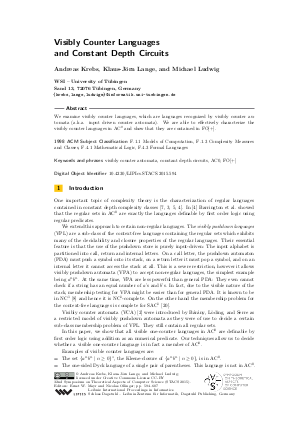Visibly Counter Languages and Constant Depth Circuits
Authors Andreas Krebs, Klaus-Jörn Lange, Michael Ludwig
-
Part of:
Volume:
32nd International Symposium on Theoretical Aspects of Computer Science (STACS 2015)
Part of: Series: Leibniz International Proceedings in Informatics (LIPIcs)
Part of: Conference: Symposium on Theoretical Aspects of Computer Science (STACS) - License:
 Creative Commons Attribution 3.0 Unported license
Creative Commons Attribution 3.0 Unported license
- Publication Date: 2015-02-26
File

PDF
LIPIcs.STACS.2015.594.pdf
- Filesize: 0.62 MB
- 14 pages
Document Identifiers
Subject Classification
Keywords
- visibly counter automata
- constant depth circuits
- AC0
- FO[+]
Metrics
- Access Statistics
-
Total Accesses (updated on a weekly basis)
0PDF Downloads0Metadata Views
Abstract
We examine visibly counter languages, which are languages recognized by visibly counter automata (a.k.a. input driven counter automata). We are able to effectively characterize the visibly counter languages in AC^0 and show that they are contained in FO[+].
Cite As Get BibTex
Andreas Krebs, Klaus-Jörn Lange, and Michael Ludwig. Visibly Counter Languages and Constant Depth Circuits. In 32nd International Symposium on Theoretical Aspects of Computer Science (STACS 2015). Leibniz International Proceedings in Informatics (LIPIcs), Volume 30, pp. 594-607, Schloss Dagstuhl – Leibniz-Zentrum für Informatik (2015)
https://doi.org/10.4230/LIPIcs.STACS.2015.594
BibTex
@InProceedings{krebs_et_al:LIPIcs.STACS.2015.594,
author = {Krebs, Andreas and Lange, Klaus-J\"{o}rn and Ludwig, Michael},
title = {{Visibly Counter Languages and Constant Depth Circuits}},
booktitle = {32nd International Symposium on Theoretical Aspects of Computer Science (STACS 2015)},
pages = {594--607},
series = {Leibniz International Proceedings in Informatics (LIPIcs)},
ISBN = {978-3-939897-78-1},
ISSN = {1868-8969},
year = {2015},
volume = {30},
editor = {Mayr, Ernst W. and Ollinger, Nicolas},
publisher = {Schloss Dagstuhl -- Leibniz-Zentrum f{\"u}r Informatik},
address = {Dagstuhl, Germany},
URL = {https://drops.dagstuhl.de/entities/document/10.4230/LIPIcs.STACS.2015.594},
URN = {urn:nbn:de:0030-drops-49447},
doi = {10.4230/LIPIcs.STACS.2015.594},
annote = {Keywords: visibly counter automata, constant depth circuits, AC0, FO\lbrack+\rbrack}
}
Author Details
References
-
Rajeev Alur and P. Madhusudan. Visibly pushdown languages. In László Babai, editor, STOC, pages 202-211. ACM, 2004.

-
Vince Bárány, Christof Löding, and Olivier Serre. Regularity problems for visibly pushdown languages. In Bruno Durand and Wolfgang Thomas, editors, STACS 2006, 23rd Annual Symposium on Theoretical Aspects of Computer Science, Marseille, France, February 23-25, 2006, Proceedings, volume 3884 of Lecture Notes in Computer Science, pages 420-431. Springer, 2006.

-
David A. Mix Barrington. Bounded-width polynomial-size branching programs recognize exactly those languages in NC¹. J. Comput. Syst. Sci., 38(1):150-164, 1989.

-
David A. Mix Barrington, Kevin J. Compton, Howard Straubing, and Denis Thérien. Regular languages in NC¹. J. Comput. Syst. Sci., 44(3):478-499, 1992.

-
David A. Mix Barrington and Denis Thérien. Finite monoids and the fine structure of NC¹. J. ACM, 35(4):941-952, 1988.

-
Mikolaj Bojańczyk and Igor Walukiewicz. Forest algebras, 2007.

-
Ashok K. Chandra, Steven Fortune, and Richard J. Lipton. Unbounded fan-in circuits and associative functions. J. Comput. Syst. Sci., 30(2):222-234, 1985.

-
Patrick W. Dymond. Input-driven languages are in log n depth. Inf. Process. Lett., 26(5):247-250, 1988.

-
Merrick L. Furst, James B. Saxe, and Michael Sipser. Parity, circuits, and the polynomial-time hierarchy. In FOCS, pages 260-270, 1981.

-
Yuri Gurevich and Harry R. Lewis. A logic for constant-depth circuits. Information and Control, 61(1):65-74, 1984.

-
Johan Håstad. Almost optimal lower bounds for small depth circuits. In STOC, pages 6-20. ACM, 1986.

-
Neil Immerman. Languages that capture complexity classes. SIAM J. Comput., 16(4):760-778, 1987.

-
Neil Immerman. Descriptive Complexity. Springer, New York, 1999.

-
Andreas Krebs and Klaus-Jörn Lange. Dense completeness. In Hsu-Chun Yen and Oscar H. Ibarra, editors, Developments in Language Theory - 16th International Conference, DLT 2012, Taipei, Taiwan, August 14-17, 2012. Proceedings, volume 7410 of Lecture Notes in Computer Science, pages 178-189. Springer, 2012.

-
Pierre McKenzie, Michael Thomas, and Heribert Vollmer. Extensional uniformity for boolean circuits. SIAM J. Comput., 39(7):3186-3206, 2010.

-
Robert McNaughton and Seymour Papert. Counter-free automata. With an appendix by William Henneman., 1971.

-
Kurt Mehlhorn. Pebbling mountain ranges and its application to dcfl-recognition. In Jaco de Bakker and Jan van Leeuwen, editors, Automata, Languages and Programming, volume 85 of Lecture Notes in Computer Science, pages 422-435. Springer Berlin Heidelberg, 1980.

-
Marcel Paul Schützenberger. On finite monoids having only trivial subgroups. Information and Control, 8(2):190-194, 1965.

-
Howard Straubing. Finite Automata, Formal Logic, and Circuit Complexity. Birkhäuser, Boston, 1994.

-
H. Venkateswaran. Properties that characterize LOGCFL. J. Comput. Syst. Sci., 43(2):380-404, 1991.

-
Heribert Vollmer. Introduction to circuit complexity - a uniform approach. Texts in theoretical computer science. Springer, 1999.

